Weapons
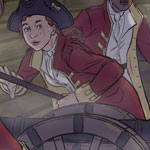
Cannons
Cannons are the undisputed masters of the battlefield. They can lay waste to battalions and pound citadels into rubble. Ships are measured by how many cannons they carry, while citadels are ranked by how many cannons they have protecting them. No other weapon provides as much destructive power as the long metal tubes that channel earth and fire to such destructive effect.
All cannons are smooth bore and muzzle loaded. Cannons have become more powerful and accurate over the centuries as philosophers have continued to make more advances in physics. Over the last century, Japethan militaries have standardized their cannons to launch 4, 6, 9, 12, 18, 24, and 32-pound cannonballs. The main pieces on a battlefield are the 4-pound and 6-pound guns. The guns with heavier ordnance are stationed in citadels and the mid-sized pieces find their way onto the gundecks of galleons.
Cannon barrels can be cast in iron or bronze. Iron is stronger and can withstand greater charge, giving iron cannons longer range and more accuracy. However, most cannons are bronze for logistical reasons. Bronze is lighter and easier to transport, and bronze can be recast after the barrel is worn while iron has to be scrapped. Even if lost at sea, bronze cannons can be salvaged and reused while iron cannons become rusted scrap in days. The barrels are superbly decorated, often with blustering engravings that read "Last Argument of Kings," "The Envied One," or "Without Equal" to show the power and majesty of the nation that can build such powerful weapons.
Carriages for cannons vary drastically depending upon the branch of service. Army cannons are housed on a carriage that has a long tail, which can be lifted and easily tied to a pair of horses for transport. The carriage has two large wheels that can traverse muddy and uneven roads and fields. On a ship, the long-tail carriage would be an impediment with the tails interlocking on the gundeck to create a hazardous obstacle course. Instead, naval carriages are blocky with four small wheels that can be rolled back and forth over the smooth deck with ease.
A crew of four to eight cannoneers are needed to work a cannon. Two act as gunners, holding the lit match and priming the cannon with powder, while the others clean and load the cannon and then move it into a firing position. A talented crew can fire a cannon four times a minute, but the effort is exhausting and the crew cannot maintain this rate for long.
Cannon ordnance comes in three types. The solid cannonball is made entirely out of iron. The shell has an outer casing of iron and is filled with gunpowder so that the shell explodes on contact with its target. Canister also has an outer casing of iron, but is filled with small bits of metal, such as musket balls. The shell breaks upon being fired from the cannon, creating an expanding cone of shredding death for two hundred meters. Cannoners are experimenting with grape shot that stores the musket balls in a leather bag and extends the range.
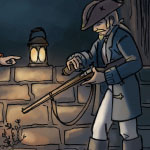
Carbines
A carbine is a shortened version of the musket designed for use in situations where longer muskets would be cumbersome. Carbines use the flintlock technology of a standard musket. Like muskets, size and weight vary, but the Marcillac carbines of the Saronnan military weigh 2.7 kilograms, measure 106 centimeters in length, and fire a 14-millimeter ball. A carbine can be affixed with a bayonet, but this is rarely done because of the short length of the barrel.
The principle advantage of the weapon is portability and its ability to be used on horseback. The carbine is short enough to hang from a bandolier and clear the rider's elbow and the horse's legs. The bandolier hooks onto a loose iron ring that is held to the left side of the carbine by a sling rail.
A carbine fires a lower-velocity ball because of the shortened barrel. As a consequence, its effective range is only 30 to 50 meters and its maximum range is 75 to 100 meters. The carbine is the preferred firearm of dragoon units, who appreciate its versatility as a mounted or on-foot weapon. The carbine can be fired while a horse is moving, but the jostling ruins what little accuracy the carbine has. Dragoons commonly save their shot to fire a single salvo into the enemy before drawing sabers to engage in melee.
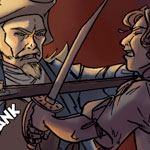
Long Knives
On the frontier of Aradie, good-quality weapons are such a precious commodity that they are virtually never discarded -- even when damaged beyond repair. Broken swords can sometimes be cut down to make a long-bladed knife, for example. Sturdier than a hunting knife, long knives typically measure about 1 foot in length. If the knife is made from the recently introduced cavalry sabers, it will retain the slightly curved sweep of the larger weapon. The hand guards can be simplified if they are too elaborate, but since the best blades are often highly decorated, many long knives retain extensive adornment. Long knives suffer a social stigma for being made from broken weapons, making them unpopular among the wealthier classes. Instead, most long knives end up in the hands of canailles, trappers, and woodsmen.
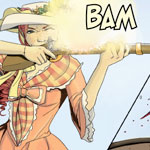
Muskets
Muskets are the most common firearm to be found in Aradie. They are relatively cheap to manufacture, reliable, and reasonably accurate for short distances. Size, weight, and calibers of muskets vary widely, but the Marcillac musket (the standard model of the Saronnan army) weighs 4.5 kilograms, measures 150 centimeters in length, and fires a 17.5 millimeter musket ball. A typical musketeer can fire three times a minute. A well-trained musketeer can fire four times a minute.
Most muskets in Aradie, including the Marcillac musket, are flintlocks. A flintlock musket is composed of three main pieces - the lock, the stock, and the barrel. The lock is the firing mechanism that utilizes a piece of flint that sparks when it strikes steel. This spark ignites a small amount of gunpowder in a flashpan, which in turn ignites the significantly larger amount of gunpowder inside the barrel. The flintlock is a significant improvement over the previously used matchlock, which used a slow-burning lit match to ignite the powder in the flashpan.
The barrels of almost all muskets are smoothbore, which means the barrel's interior is smooth and not rifled. Musket balls rattle around inside the barrel, especially since military units fire a ball that is much smaller than barrel as gunpowder from repeated firings fouls the inside of the barrel. This loose fit causes the ball to exit the barrel at a slight angle, giving the weapon an effective range of 50 to 75 meters even though the musket has a maximum range of 100 to 200 meters.
The stock of a musket is solid wood and usually made out of walnut. It is heavy enough that it can be used as a club in melee combat. It is also long enough that if the barrel is fitted with a bayonet, the musket can become a respectable pike.
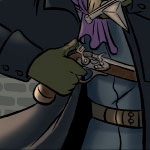
Pistols
Flintlock pistols are short-barreled weapons designed to be held and fired with one hand. They are usually smoothbore, but some are rifled. Their light weight and convenience balance out their extremely short effective range of 10 to 15 meters. They come in a wide variety of sizes and calibers, from the dainty pocket pistol to the heavy and powerful dragoon pistols. The pocket pistol is 15 centimeters in length, weighs 1 kilogram, and uses an 11-millimeter ball. Dragoon pistols are 50 centimeters in length, weigh 1.8 kilograms and fire a 17.5-millimeter ball. A recent innovation for the pocket pistol is the “cannon barrel.” For this design, the barrel screws off, and the user loads the powder and ball directly into the base of the barrel. This eliminates the need for a ramrod.
Pistols are not nearly as common in Aradie as the musket, which is more useful in the vast Everique wilderness. Pistols are used for self-defense by many civilians, who prefer the pocket pistols. The military issues the heavier pistols to officers and cavalry, who frequently use them in conjunction with a saber. In addition, pistols have become popular among the younger nobility as dueling weapons, challenging the traditional sword. The older generation disdains this development, claiming that it takes less skill and training to simply point a pistol and pull the trigger than to cross blades. Dueling pistols have longer barrels than common flintlock pistols to give them better accuracy, but genteel society considers it dishonorable to use a rifled pistol.
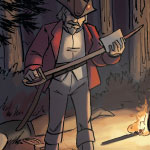
Sabers
A saber is a sword with a curved, single-edged blade and a large hand guard that covers the knuckles of the hand as well as the thumb and forefinger. The blade averages about 3 feet in length. The fully closed hilt offers good protection for the hand and much better control over the saber. It is ideal for horseback fighting and allows for faster and stronger strikes, particularly when the attacker has a height advantage over the defender. Although it has been used for centuries on the vast plains of Vaspaar in central Japethe, the saber has only recently come into vogue in the countries of western Japethe, who have begun to equip their cavalry units with this effective and deadly blade.
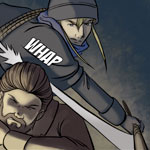
Saps
A sap is a weapon designed to knock the target out. Saps come in a wide variety of shapes, sizes, and materials, but the basic principle always remains the same -- a soft covering over a dense, weighted core. The outer sack may be made of cloth materials such as a wool sock, but most saps are encased in leather. The dense core is commonly made of lead, sand, or clay with lead being the most popular. This core connects to a handle of some sort, which might be the other end of the sock or a shaft of stiff leather. Most saps are six to eight inches long. Flatheaded saps are commonly called beavertails, while round-headed ones are called blackjacks.
Saps are versatile weapons well suited for the skullduggery of Iniquity Row. They fit comfortably in a pocket, a boot, or a waistband and go unnoticed until pulled out. They are rarely lethal, which avoids unpleasant inquiries from the gendarmerie. A well-placed shot on the shoulder can make an arm go numb, and the sap has the capability of knocking someone out. This is done by a blow to the head, usually in the temple area above the target's ear. Skill is needed to place such a blow and is very difficult to land in combat so most wielders attempt to catch the target by surprise.
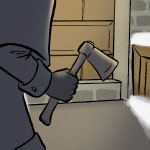
Tomahawks
Sometimes spelled tomahak, this hatchet is composed of an iron head with a cutting edge of 12 centimeters (5 inches). The shaft is about 60 centimeters (2 feet) long and made of hickory, ash, or maple. The heads of most tomahawks weigh about 1 kilogram (2 to 3 pounds). The tomahawk is primarily used as a chopping tool, but is often used as a melee or thrown weapon.
When the first explorers from Japethe arrived in the new world, the natives were eager to trade their furs and goods for the hatchets the sailors used on board their ships. As the fur trade developed, the hatchets became valuable trade goods with widespread demand for the tools by the natives. Today, smiths in Saronne, Morante, and Kleef make tomahawks in vast numbers specifically as trade goods for the natives of Everique. To keep weight and costs down, the heads are shipped without shafts and are fitted with shafts when they arrive in Aradie. Originally this was done in Sherbourg, but as the fur frontier pushes deeper into the interior, the process has moved up the Grande Vire river.
The tomahawks from Saronne are distinctive for their ovoid eye for the shaft while those from Morante and Kleef have round eyes. The Saronnans say that this makes the head less likely to spin on the shaft. Many of the tribesmen agree, preferring the Saronnan tomahawks.
« Return to the Almanac Index

